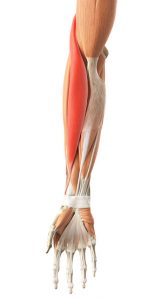 Brachioradialis pain occurs when the muscles in the forearm are overexerted. The brachioradialis is a muscle that serves to provide flexion at the elbow as well as support the extension of the wrist, and it spans the length of the forearm from just above outside of the elbow to the thumb side of the wrist. An example of this muscles activation can be appreciated when lifting a suitcase straight up, with the palms facing towards the ground (pronated) and elbows kept at the sides of the body. For reference sake, palms facing up is called supination and can be easily remembered if you imagine holding a bowl of soup—supination.
Brachioradialis pain occurs when the muscles in the forearm are overexerted. The brachioradialis is a muscle that serves to provide flexion at the elbow as well as support the extension of the wrist, and it spans the length of the forearm from just above outside of the elbow to the thumb side of the wrist. An example of this muscles activation can be appreciated when lifting a suitcase straight up, with the palms facing towards the ground (pronated) and elbows kept at the sides of the body. For reference sake, palms facing up is called supination and can be easily remembered if you imagine holding a bowl of soup—supination.
The brachioradialis muscles bring the forearms back in a neutral position after it has been supinated or pronated. Additionally, this muscle stabilizes the wrist when gripping objects and prevents the wrist from bending, which is the motion that the flexors of your hand and wrist would make with powerful gripping motions. Another function of the brachioradialis muscles is to stabilize the elbow, as it moves very fast and high centrifugal forces develop—a common occurrence when punching.
Brachioradialis pain symptoms and trigger point activation
Advertisement
Brachioradialis pain can be appreciated if the muscles in the forearm become very tight, sending shooting pain up the forearm or elbow during use. Some cases include pain that may extend to the back of the hand and even into the index finger and thumb. The pain is often confused with a condition called “tennis elbow,” but this is due to inflammation of the tendons of the elbow due to overuse, with brachioradialis pain only being a contributor and not a cause.
Brachioradialis pain may be felt during the following movements:
- Turing a door knob
- Shaking hands
- Drinking a cup of coffee
- Using a screwdriver
What causes brachioradialis pain?
Overexertion is one of the main causes of brachioradialis pain and it occurs due to overloading of the muscle for extended periods of time. This leads to the muscle being tender and eventually triggering pain. Manual labor is the most likely causative action leading to brachioradialis pain, but activities such as playing tennis or even typing on a computer for an extended period of time can also trigger brachioradialis pain, as they all involve repetitive movements. Generally, brachioradialis pain causes involve frequent lifting, twisting, or holding up objects that may put increased levels of stress on this muscle, leading to forearm pain.
Sudden trauma may also be a cause, as blunt force or a fall can harm muscle tissue. The muscle may pull or tear if it is strained past what it is physically capable of doing, leading to injury. Trauma to the brachioradialis muscle may cause a sharp pain initially, which often progresses to a steadier aching pain along with stiffness, tenderness, and swelling, requiring brachioradialis pain treatment.
How to treat brachioradialis pain?
After an injury or strain to the brachioradialis muscle has occurred, treatment options often include pain control, healing period, and restoration of function. Physical therapists can help develop individualized rehabilitation plans to fit the unique needs of each patient. The following are treatment modalities commonly employed:
- Initial care: After an injury to the brachioradialis muscle, rest the affected arm for 48 to 72 hours. This will help the healing process. Applying ice in 20-minute intervals every one-to-two hours will help minimize swelling, with elastic compression wraps being useful for severe cases of swelling. If brachioradialis pain and swelling are due to blunt injury, it may be useful to elevate the affected arm to reduce any internal bleeding if present. Brachioradialis pain relief may be treated with medications at the discretion of your doctor.
- Range of motion exercises: Gentle brachioradialis stretch exercises can be done depending on the level of pain currently experienced. Bending and straightening the elbow and wrist, plus wrist rotations for at least five minutes are good ways to start range of motion exercises. More advanced stretching involves extending the arms behind the back with the hands together until a light tension is felt through the front of the elbow and upper arm, holding the position for 10 to 30 seconds, deepening the stretch with each breath. Dynamic stretching can be achieved by swinging the affected arm backward and forwards with the palm facing inward.
- Isometric exercises: This involves contracting the brachioradialis muscle statically for a specific period of time. This can be achieved by holding dumbbells while standing and lifting the weights about three inches forward, and holding the position. Repeat this exercise until you reach a point where the elbows can become fully flexed, which will happen over time.
- Strength training exercises: It is best to seek the advice of a physiotherapist to determine how soon you can start lifting heavy weights. Curling exercises, such as the hammer curl and reverse curl, target the brachioradialis muscle. Brachioradialis pain when curling may prevent one from performing these various exercises and is, therefore, cautioned to not overextend the muscle again for risk of repeat injury.
Related: Top 12 natural muscle relaxers to fix aches and pains
